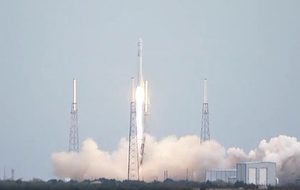
Just a few hours ago, SpaceX launched its third flight to the International Space Station tasked with carrying precious cargo as part of its current contract with NASA. Shortly after the 10:10 AM EST launch of the Falcon 9 from Cape Canaveral, however, the Dragon Capsule experienced a glitch shortly after parting with its rocket.
The liftoff was smooth as a whistle, but once in orbit a problem surfaced just after spacecraft separation, when the Dragon capsule was expected to deploy its solar arrays. These solar arrays are essential to powering the capsule, however there are still more than 15 hours left, as of typing, of battery life – hopefully enough for SpaceX engineers to remedy to issue .
UPDATE: SpaceX waited until the Dragon Capsule hovered over Australia where communications between ground stations and orbiting spacecraft is best. Engineers overrided an inhibit instruction that was preventing two of the three thruster pods from working properly. Dragon’s 54-foot-wide solar arrays have been thus deployed successfully averting any kind of danger to the mission. Some re-arrangements will be required, however, as a result of the delay.
The Dragon capsule is carrying around 1,200 pounds of cargo to the International Space Station, including important scientific experiments that will be deployed on the station and then ferried back on Earth. Some crew care items have also been deployed, like fresh apples much to the delight of the stationed astronauts.
As an interesting side note, during yesterday’s pre-launch conference SpaceX president Gwynne Shotwell offered the first insights as to why the Falcon 9 engine shut down during a launch in October. Apparently, a “material flaw in the jacket of the engine” was the root of the problem, though the subject wasn’t elaborated in detail.


